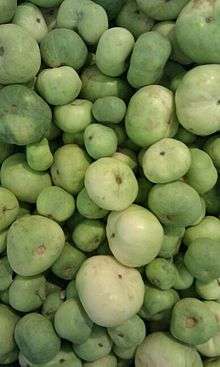Tinda
| Tinda | |
|---|---|
 | |
| Scientific classification | |
| Kingdom: | Plantae |
| Clade: | Angiosperms |
| Clade: | Eudicots |
| Clade: | Rosids |
| Order: | Cucurbitales |
| Family: | Cucurbitaceae |
| Subfamily: | Cucurbitoideae |
| Tribe: | Benincaseae |
| Genus: | Praecitrullus Pangalo |
| Species: | P. fistulosus |
| Binomial name | |
| Praecitrullus fistulosus (Stocks) Pangalo | |
| Synonyms | |
| |
Tinda टींडा (Urdu: ٹنڈه or ٹنڈے), also called "Indian squash", "round melon",[1] "Indian round gourd" or "apple gourd" or "Indian baby pumpkin", is a squash-like cucurbit grown for its immature fruit, a vegetable especially popular in South Asia. It is the only member of the genus "Praecitrullus". Tinda is also called "tindsi" in Rajasthan. In Marathi, it is called dhemase ढेमसे. In Sindhi language, it is called meha (Sindhi: ميها).
The plant is as with all cucurbits, a prolific vine, and is grown as an annual. The plant also is prickly with small thorns similar to the Zucchini. The fruit is approximately spherical, and 5–8 cm in diameter The seeds may also be roasted and eaten. Tinda is a famous nickname among Punjabi families in India. This unique squash-like gourd is native to South Asia, very popular in Indian and Pakistani cooking with curry and many gourmet dishes. Green colored, apple sized fruits are flattish round in shape and 50-60 grams in weight. Plants are vigorous, productive and begin to bear fruits in 70 days after planting.
Tinda can be confused with tendli or kundru due to similar-sounding names from different languages and regions. Tinda in Punjabi or most North Indian languages is "Indian baby pumpkin".
References
- ↑ "NEWLY NOTIFIED VARIETIES OF SEEDS". Seednet.gov.in. Retrieved March 4, 2017.
External links